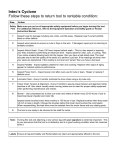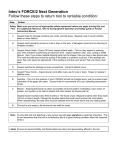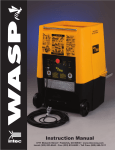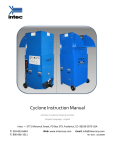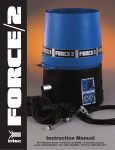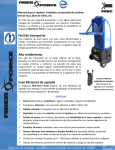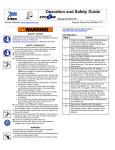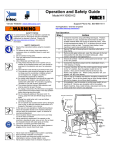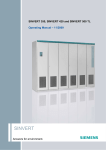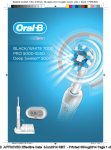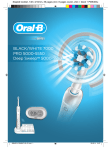Download Intec K30000-01 Installation Guide
Transcript
Instruction Manual 3771 Monarch Street • Frederick, CO 80530 • www.inteccorp.com Local: (303) 833-6644 • Fax: (303) 833-6650 • Toll Free: (800) 666-1611 CONTENTS FORCE/3 3.0 & 4.0 DP Table of Contents Machine Information......................................................................2 Introduction ....................................................................................3 Specifications ..................................................................................4 Electrical Drawings ........................................................................5 The System ....................................................................................7 How the System Works ................................................................8 Set-Up and Operation ..................................................................10 Safety First ....................................................................................11 Operational Guidelines ................................................................14 Sidewall Tech Notes ....................................................................15 Operating With a Generator / Using Additional Extension Cords ..............................................17 Maintenance..................................................................................19 Troubleshooting ..........................................................................23 Making a Claim for Damage or Loss ..........................................28 Returns ..........................................................................................29 How to Receive Replacement Parts Under Warranty ................31 Warranty........................................................................................32 Glossary ........................................................................................34 1 Rev 3/06 2 MACHINE INFORMATION Thank you for purchasing an Intec insulation system. Since 1977, both professional contractors and do-it-yourself equipment users have looked to Intec as the industry leader in the design and manufacture of innovative portable insulation blowing equipment. We take pride in making your job as easy and profitable as possible. The right system for your needs: Intec strives to provide you with the best combination of portability, functionality, and installation versatility to surpass your desired success. From lightweight polyethylene units with removable hoppers, to larger units with increased production rates and installation versatility, all of our durable systems are made to maximize your profit generating potential. Best-in-class Customer Service: Total ease of use extends beyond your initial purchase of an Intec system to your evolving needs thru the entire lifecycle. Both before and after the sale service is important to keep you running at peak operating capabilities. Intec’s technical team provides installation assistance in addition to maintenance suggestions and trouble-shooting support. In addition to blowing machines, Intec produces a range of accessories that will increase your productivity when dense packing, damp spraying, and installing net and blow. Thank you for partnering with Intec. We appreciate the confidence and trust you have placed in us, and wish you many profit-generating opportunities! Ray Lavallee President INTRODUCTION Intec appreciates your business Height 51" (129 cm) Width 31" (76 cm) Length 53" (130 cm) Weight 350 lbs (130kg) Hopper capacity 75 lbs (27kg) Hose size 3" (7.35 mm) Blower 5.7 diameter 2-stage 3.0 PSI (2 blowers) Blower 7.2 diameter 2 Stage 4.0 PSI (2 blowers) Drive motor 1-1⁄2 HP Transmission Worm gear/Chain Airlock 12" x 14" steel, 6 vanes Electrical 3.0 version 115V / 35 amp @ 60 Hz Electrical 4.0 DP version 115 V / 41 Amps @ 60 Hz Agitator 5 blade Wheels 2" x 10" Poly Warranty One year limited; 90 days electrical, blower, airlock system. Note: All specifications are subject to change without notice. Width 30" Length 53" 4 SPECIFICATIONS Specifications 3.0 & 4.0 DP Height 51" SPECIFICATIONS FORCE/3 3.0 & 4.0 DP Electrical Drawings 110V STD. ELECTRICAL WITH VARIABLE SPEED CONTROL 5 ELECTRICAL DRAWINGS ELECTRICAL DRAWINGS FORCE/3 ELECTRICAL DRAWINGS, CONT. FORCE/3 3.0 & 4.0 DP Electrical Drawings, Cont. 110V STD. CONTROL WITH NO VARIABLE SPEED. CONTROL 6 The System 3.0 & 4.0 DP Three sub-systems make up your FORCE/3: THE AGITATOR AND AIRLOCK. The FORCE/3 uses a 1-1⁄2hp motor and is coupled to a worm gearbox to reduce the speed of the motor and increase torque. In addition to the motor and gearbox, chain and sprockets are used to further reduce the speed of the airlock. THE BLOWER MOTOR(S). The FORCE/3 3.0 is equipped with two 5.7" 128 CFM three stage blowers to push the material through the hose and into the attic with optimum pressure and output. The Force/3 4.0 DP is equipped with two 116 CFM two stage blowers which produce over 4.0 PSI through the airlock. ELECTRICAL SYSTEM. The FORCE/3 3.0 requires 2 separate dedicated 20 amp grounded circuits. Low voltage or amperage may likely cause tripping (blowing) of house circuit breakers or chattering of contactor (relay). The Force/3 4.0 DP requires 2 dedicated circuits, 20 & 30 amp. Due to the high current draw of this machine you will need to use a 10.5KW generator to properly operate it. Never attempt to operate the FORCE/3 in standing water! Always disconnect all power to the equipment before attempting repair; otherwise bodily injury or death may result. THE PARTS. 1. Hopper: upper component of the FORCE/3 where insulation is loaded. 2. Frame: Lower part of the machine that supports the entire machine. 3. Side panels: surround the outside of the machine to aid in protection during operation. 4. Electrical: on/off function for both the blower and agitator motors. 7 THE SYSTEM FORCE/3 HOW THE SYSTEM WORKS FORCE/3 3.0 & 4.0 DP How the System Works AGITATOR: The five-arm agitator is essential in helping attain the high production rates by conditioning and sweeping the material into the airlock. AGITATOR MOTOR: The agitator motor is attached to the gearbox which produces the torque to power the Agitator and Airlock components. AIRLOCK: The airlock picks up and rotates the conditioned material into the air stream of the blowers. Airlock seals must be inspected and maintained in order to ensure maximum blowing efficiency. m Keep all foreign objects out of airlock to prevent seal or airlock damage BLOWER(S): Force/3 3.0 uses two 128 CFM blowers to develop a minimum pressure of 3.0. The Force/3 4.0 DP uses two 115 CFM blowers to develop a minimum pressure of 4.0. The two blowers are housed in one assembly to create the needed airflow for the material to be discharged from the airlock. The insulation material does not pass through the blower, thus increasing the life of the machine. 8 3.0 & 4.0 DP How the System Works, Cont. VARIABLE SPEED CONTROL V.S.C.: The variable speed control regulates the airflow of the blowers. This feature is used when applying spraywall material or dense packing sidewalls. GEARBOX: The gearbox is driven by the agitator motor and rotates both the agitator and airlock components. This gearbox is permanently lubed for life and does not require any lube change. Periodically remove build up of insulation dust on gearbox and agitator motor to prevent overheating. REMOTE CONTROL: The remote cord is 100' or 150' in length and is permanently attached to the machine. The operator can control both “on” / “off” functions of each motor with the remote cord, and in an emergency the operator on the ground can shut the machine off by using the main electrical switches. SLIDE GATE: The slide gate regulates the amount of material entering the airlock. To increase material flow, pull slide gate out; to decrease material flow, push slide gate in. 9 HOW THE SYSTEM WORKS, CONT. FORCE/3 3.0 & 4.0 DP Set-Up and Operation OPERATION: The FORCE/3 is designed to handle bulk packaged insulation material. As material is loaded into the hopper the agitator breaks up and conditions the material for proper density while sweeping the material down into the airlock. The airlock rotates the material 180 degrees from the lower hopper opening into the airflow created by the blower system which discharges the material through the hose. As the material travels through the hose it is buffeted up against the interior sides of the hose to further conditioning of material. ELECTRICAL HOOK-UP: Both power cords need to be plugged into two separate circuits that are independent of other equipment. Both circuits need to be rated at 115VAC/20 Amp each in order for the machine to function properly. Failure to use two independent circuits will result in continued tripping of circuit breakers within the electrical distribution box or chattering of contactors (relays). When connecting the power cords to the machine, make sure all the switches are in the “off” position. Force/3 4.0 DP must be used on at least a 10.5KW generator. This is due to the high current draw of the blowers. HOSE HOOK-UP: Attach the 3" x 50' plastic hose to the outlet of the machine and secure the hose with a 3 inch hose clamp. The length of hose does aid in the conditioning process and it is not recommended to use less then 100' of blowing hose. You may use a maximum length of 200' of any one size of hose. ATTIC PREPARATION: Be sure that all chimneys, flus and heat generating devices are not covered before insulating. Attic chutes need to be installed for proper ventilation and portable lighting set up prior to installing. Additional information on how to prepare your attic for insulation is available from your local building or home center. OPERATION BY REMOTE: Position both switches on the main electrical panel to the “on” position to allow control of the machine via the remote cord. 10 SET-UP AND OPERATION SET-UP AND OPERATION FORCE/3 3.0 & 4.0 DP Set-Up and Operation, Cont. OPERATION FROM ELECTRICAL PANEL: Position both switches on the remote cord to the “on” position to allow control of the machine at the main electrical panel BLOWING IN THE ATTIC: Start the job at the farthest point from the entrance of the attic and work your way back to the entrance. Use the shortest hose possible to ensure maximum production and use the slide gate to optimize the air to product ratio. Blow the material at waist level and parallel to the joists to the desired depth. Using the remote cord, turn “on” or “off” the desired motor to assist you in moving around the attic. Do not use less than 100 feet of blowing hose. Failure to do so will cause improper coverage and conditioning of material. FIBERGLASS SETUP: When blowing premium blowing wool, i.e. Certainteed Insul-Safe IV, Guardian Prowhite III or Johns Manville Climate Pro it is strongly recommended that 150' of hose be used. The extra 50' section allows for additional conditioning of the material, which is beneficial for proper density and coverage. For optimum results use 3" hose for the first 100' and reduce down to 2-1⁄2" for the last 50'. This hose configuration helps attain maximum conditioning, giving the operator maximum loft at the end of the hose. Do not use your hand at the end of the hose to direct material, as this affects the conditioning process and is not recommended by the insulation manufacturers. CELLULOSE SETUP: When blowing light density cellulose it is recommended that the operator use a minimum of 100' of 3" hose allowing for the extra conditioning of the material needed to achieve the proper density and coverage. If coverage is not per the manufacturer’s specifications on the bag, reduce the slide gate opening by 25% and add an additional 50' of 3" hose. Note: Some cellulose materials are manufactured by injecting liquid into the paper to make the cellulose fire retardant. This may cause poor or low coverage of the material during colder seasons as the material can freeze and become chunky. If you continue to experience poor coverage after reducing the 11 SET-UP AND OPERATION, CONT. SET-UP AND OPERATION, CONT. FORCE/3 SET-UP AND OPERATION, CONT. FORCE/3 3.0 & 4.0 DP Set-Up and Operation, Cont. slide gate and adding additional hose, contact the cellulose manufacturer for additional information and recommendations. HOPPER SAFETY: Safety is the most important consideration when using any machine. Failure to follow safety precautions may result in permanent injury or possible machine failure. Follow all safety rules provided by the manufacturer of the insulation material , including wearing protective masks or respirators. Do not put hands inside of the hopper while the machine is operating. If a foreign object is dropped into the hopper, immediately shut the machine off, unplug the power to the machine and remove the foreign object. Do not overload the hopper or place objects other than insulation material into hopper, as this may cause personal injury or possible machine failure. m Never wear loose clothing while running this machine. LOADING THE HOPPER: When loading the machine, empty only one bag at a time into the hopper to prevent overloading of agitator motor. Wait until half of the contents have been used before adding more material. Cellulose can be loaded by placing the bag on the hopper struts and cutting the bag open length-wise, using a retractable razor knife. Once the bag has been cut, dispense the material into the hopper and allow the agitator to feed the material into the airlock. Cut all bags of fiberglass into three equal sections widthwise. Load each section separately, allowing the material to be broken up before loading additional material. Note: To facilitate loading of fiberglass insulation, hopper struts may be removed. 12 Safety First m 3.0 & 4.0 DP When working with insulation, always wear a long sleeve shirt, gloves and a hat. Wear goggles or safety glasses for eye protection and a 3M brand #8710 nose/mouth mask or equivalent for respiratory protection. m m m m m m m Never put your hands into the hopper while the machine is operating. Keep tools and foreign objects out of the hopper. Clean all material out of the hopper and the hose after each use. Never leave the machine unattended during operation. Disconnect all power to the machine when unattended. Never operate equipment while standing in water as electrical shock may result. Always use grounded extension cords when operating equipment. Never operate the equipment with the access panels off, possible injury may occur. Disconnect all power cords (extension cords) prior to working on the equipment, failure to do so may result in injury or death. 13 SAFETY FIRST FORCE/3 OPERATIONAL GUIDELINES FORCE/3 3.0 & 4.0 DP Operational Guidelines BLOWING SIDEWALLS, CELLULOSE: When blowing sidewalls, use the following settings and recommendations as guidelines. Settings may change from job to job, material to material, or nozzle to nozzle. Hose length and humidity may affect your results. Two hole method, standard wall construction: 2" x 4" x 16" on center. Air setting 100% Hole size 2" 1" 5/8" Slide gate opening 4" 2" 1" Keeping the material level consistent in the hopper will aid in achieving good sidewall densities. A gradual transition in hose size will aid in the material flow and help eliminate clogging. Start at the machine with 50' of 3" hose, connect 50' of 2-1⁄2" next and then connect 50' of 2". Use hose reducers and clamps to connect the hose making sure all connections are tight. If clogging or less than satisfactory compaction occurs, adjust the slide gate inward by 1⁄2" increments until the situation clears. If the problem persists, add an additional 50' of 2" hose and readjust the slide gate setting, maximum hose length, 200 feet. BLOWING SIDEWALL (DENSE-PAK): Drill two holes into the wall, one 17" (approx) from the bottom and one 17" (approx) from the top of the cavity. Always use the largest hole possible to prevent clogging. Starting with the bottom hole, put the insulation nozzle into the hole, using the remote, turn the blower on first, then the agitator. Fill the cavity until the material stops flowing, turn off the agitator and allow the blower to push additional material into the wall. Turn off the blower and wait until pressure in line has dissipated before removing the insulation nozzle. Repeat the steps for filling the cavity through the top hole. 14 FORCE/3 3.0 & 4.0 DP Sidewall Tech Notes The information below is to be used as a guideline. Results may differ due to construction & material. 2" x 4" x 16" on center, 2.8 cubic feet per cavity CELLULOSE COVERAGE 1.6 pound material density, 18.7 pound bag Wall pack density 4.0 lbs Pounds per cavity 11.2 pounds 3.5 lbs 9.8 pounds 3.0 lbs 8.4 pounds Average yield with cellulose: 1.9 cavities per 18.7 pound bag FIBERGLASS COVERAGE Johns Manville Climate Pro, 25.5 pound bag Wall pack density 1.7 lbs Pounds per cavity 4.65 pounds Average yield with JM Climate Pro: 5.8 cavities per 25.5 pound bag CertainTeed InsulSafe SP , 31 pound bag Wall pack density 1.8 lbs Pounds per cavity 5.04 pounds Average yield with CertainTeed InsulSafe SP: 6.15 cavities per 31 pound bag. Above examples may differ due to change in material design. Consult the individual insulation manufacturer for more information. FIBERGLASS WET SPRAY COVERAGE Guardian Attic Guard PLUS 33 pound bag Wall pack density Pounds per cavity 2.2 pound 6.16 pounds Average yield per bag 5.36 cavities per 33 pound bag Use a minimum of 100’ of hose for proper conditioning. For additional information on Attic Guard PLUS contact Guardian Fiberglass @ 800-748-0035 and ask for technical assistance. 15 SIDEWALL TECH NOTES, CONT. FORCE/3 3.0 & 4.0 DP Sidewall Tech Notes, Cont. CELLULOSE WET SPRAY Your Force/3 can apply both wall-spray and spray-on materials. There are many different types of material for these applications and depending upon the material your results will differ. The Force/3 has been designed to apply most materials and can recycle up to 50/50 blend of Dry/Wet cellulose material. Using recycled material will change the speed of the material traveling through the hose and will change the impact velocity and thus the density of the material being sprayed. It is recommended that you test a small area of wall section to determine optimum machine settings before starting a job. Loading of the hopper can affect the desired wall-spray job, we recommend that when loading the hopper DO NOT dispense wet material into an empty hopper!, doing so may clog hose! Dispense wet material on top of dry material and allow the agitator to blend the materials. Hose length and nozzle orifice size and design play a key role to a successful application. Depending on the nozzle you select will determine how to set up the machine. General guideline for setting your machine up are, 100 feet of 2 or 2-1/2" hose, variable speed setting of 80-100% with the slide gate 1/4-1/3 open. When using 2 or 2-1/2" hose we recommend using an insert tube (PN 22049-06) to enhance setup and reduce the likely hood of clogging the hose. For further information on Cellulose Wall-Spray or Spray-On applications consult Intec or your local supplier of material. FIGURING WALL CAVITY AREA Measure wall cavity in inches. Multiply depth x width x height, divide by 1728. Example: 3-1⁄2" x 14-1⁄2" x 92-5⁄8" = 4700 CI / 1728 = 2.72 cubic feet (1728 is the number of cubic inches per cubic foot) 16 3.0 & 4.0 DP Operating With a Generator / Using Additional Extension Cords USING A GENERATOR: Both the Force/3 3.0 & 4.0 DP operate best when using a use a commercial sized generator. The start up requirement for both Force/3 machines is 10.5KW. Normal running wattage for the Force/3 3.0 is 4025 watts and the 4.0 DP is 4680 Watts. We recommend using a minimum wattage of 10.5KW. While many brand name generators (Honda, Generac, Yamaha, Coleman) are of high quality, they are not commercial grade and are not built to handle the high in-rush current that is needed to start the agitator motor. Consult Intec for further information or your local generator reseller. Using a generator of insufficient size will cause internal motor damage and will void machine warranty. FORCE/3 MOTOR SPECIFICATIONS: Blower 5.7 diameter 10.2 Amps @ 115 Volt x 2 blowers = 20.4 Amps Blower 7.2 diameter 13.0 Amps @ 115 volt x 2 blowers = 26 Amps GE (model C371) 14.7 Amps @ 115 Volt Leeson (model 110420.00) 17.2 Amps @ 115 Volt ADDITIONAL EXTENSION CORDS: The FORCE/3 is supplied with the correct size power cords to deliver the proper voltage to the motors. If you require additional extension cords please follow the table on page 18. A smaller sized extension cord is not advised and will lead to electrical or motor failure. 17 OPERATING WITH A GENERATOR / USING ADDITIONAL EXTENSION CORDS OPERATING WITH A GENERATOR / USING ADDITIONAL EXTENSION CORDS FORCE/3 3.0 & 4.0 DP Operating With a Generator / Using Additional Extension Cords, Cont. Cord Current Capacities, Type S & SVT Wire Size AWG 10 12 14 16 18 3 Conductor Amps 25 20 15 10 7 It is recommended that if you need additional cord to run the machine, use the next gage size up. (Note: in the electrical world, the lower the (gage) number the larger the wire size). Consult Intec for your specific needs or your local electrical distributor. 18 OPERATING WITH A GENERATOR / USING ADDITIONAL EXTENSION CORDS, CONT. OPERATING WITH A GENERATOR / USING ADDITIONAL EXTENSION CORDS, CONT. FORCE/3 Maintenance 3.0 & 4.0 DP Preventative maintenance will help ensure the FORCE/3 gives you many years of satisfactory use. Clean the interior and exterior of the machine weekly to help maintain the longevity of the motor, blowers, gearbox and chain, as well as the finish. This machine has been designed to work in a dusty environment , however, without periodic cleaning and servicing the performance of the machine will decline or mechanical failure will occur. Clean intake air filter and motor air filter at least once per week. (Intake air filter is located on the underneath side of the blowers.) CORDS AND SWITCHES The power cords, remote cord and switches are subject to considerable wear and tear during normal operation. Inspect all cords prior to use to ensure safe operation. If any damage is observed, be sure to repair it before operating the machine to avoid personal injury. Note: Do not pull on power while plugged into machine or damage may occur. The Force/3 comes with two 10/3 power cords. Each twist lock plug-in has a built-in LED indicator which will let the operator know if the power cord has electricity or not. If the LED is glowing green then power is present, if not check power cord to ensure that it is plugged in at the wall outlet or check for tripped circuit breaker. Rocker switches in the remote box may need to be replaced from time to time. When replacing the switches make sure to replace them with the same rated switch to ensure proper operation of the machine. Use only 15A or 20A @ 110V rated switch. Failure to do so may cause electrical failure. AIRLOCK & SEALS The airlock is one of the most important items to keep in good condition. Foreign objects in the airlock chamber can cause damage and reduce the production of the machine. The most common failure in the airlock is the seal of the airlock vane to hold the compression from the blower. Failure of this seal will cause blow back of air into the upper hopper and reduce production. It is recommended that the seals be visually inspected for cuts and tears each week to ensure proper running condition. Airlock seals should be replaced every 300 hours or once a year. 19 MAINTENANCE MAINTENANCE FORCE/3 MAINTENANCE, CONT. FORCE/3 3.0 & 4.0 DP Maintenance, Cont. AIRLOCK SEAL REPLACEMENT Removing airlock rotor assembly Prior to replacing the airlock seals make sure all electrical power to the machine is disconnected and the insulation material has been emptied. Tools required: Allen wrench, 7/16 socket, ratchet and wrench, #2 Phillips screwdriver. Remove side panels from machine using the #2 Phillips Airlock Seal screwdriver. Locate the chain tensioner and use the #2 Phillips screwdriver and 7/16 wrench to loosen tension on chain. Loosen the sprocket and bearing set screws using Allen wrench (sprockets and bearings have 1 - 2 set screws). On the opposite sides of the airlock, loosen setscrews on bearing. Rotation Using a 7/16 ratchet and wrench remove the bolts and nuts securing the end plate to the airlock and frame. Remove end plate from airlock and remove the airlock rotor. Note: It is necessary to remove the sprocket and the chain before attempting repair. Replacing Seals Remove all bolts and nuts from airlock rotor plates to remove the old airlock seals. Insert new airlock seals in the plates and re-attach all hardware. Do not over tighten the bolts or you will distort the airlock seal and cause premature wear. Spray WD-40 or equivalent into the airlock, insert airlock rotor, line up bolt holes and attach end plate. Secure all fasteners on airlock, align sprocket bearing and chain tensioner, and tighten all setscrews. Note: It may be necessary to remove the bearing on end plate to ensure ease of installation of the airlock rotor. Use 9/16 wrench to remove bearing. 20 3.0 & 4.0 DP Maintenance, Cont. CHAIN TENSIONER The chain tension between the agitator and the airlock rotor is self-adjusting and should never need maintenance. GEARBOX The gearbox is sealed for life and should not require any maintenance. Periodically remove buildup of insulation dust from gearbox case to prevent overheating and ensure trouble free life. BLOWERS Keeping the blowers clean will help reduce the likelihood of overheating. Overheating will cause damage to the bearings and motor windings. The blowers have two filters, The air intake is for cooling the motor and is located on top of the motor the vacuum fan intake is located on the underneath side of the machine. and has a metal filter to protect the fan blade from picking up large particles of insulation.. The motor filter should be cleaned twice a week, using compressed air to remove dust or wash in water and dry before using. It is recommended that the motor filter be changed every month. The filters (which are knee high panty hose) can be purchased at any local grocery store. The (vacuum fan filter) vacuum filter is located on the underneath side of the frame and should be cleaned weekly. Vacuum fan filter, reach underneath the blower mounting plate and locate the frame of the metal filter, push outer edge of frame towards airlock until it stops, pull down on filter to remove. To clean, use soap & water and allow to dry for 24 hours or use compressed air to blow out. 21 MAINTENANCE, CONT. FORCE/3 3.0 & 4.0 DP Maintenance, Cont. BLOWER BRUSH & REPLACEMENT The FORCE/3 blowers use carbon brushes for operation. These brushes need to be periodically inspected to ensure high performance. Replace brushes if they are 3/8 inch or shorter. Failure to replace short brushes may cause irreversible damage to the motor. Motor air intake Blower brush, 2 brushes per blower motor Vacuum air intake 22 MAINTENANCE, CONT. MAINTENANCE, CONT. FORCE/3 3.0 & 4.0 DP Troubleshooting Problem Cause Remedy Agitator does not operate Power cord is not receiving electricity Check circuit breaker or fuse box at electrical source. Loose power cord and or extension cord. Check to make sure all cord ends are in good physical condition and are in good electrical condition. (Electrical panel) Rocker switch Depress rocker switch on electrical panel to the is not in the “on” position. “on” position. . Jam of material between the blade of the agitator and airlock or sidewall. Disconnect electrical from power source. Remove material in hopper, locate jam and/or remove foreign object. Start capacitor failure on agitator motor. Have capacitor replaced by a qualified technician. Call Intec for nearest service center location. Main panel rocker switch for agitator motor has failed Replace with original factory part rocker switch. Loose wire inside electrical system. Have the system inspected by a qualified technician. Call Intec for nearest service center location. Loose wire at electrical terminal strip. Pull test all wires and tighten all screws. 23 TROUBLESHOOTING TROUBLESHOOTING FORCE/3 3.0 & 4.0 DP Troubleshooting, Cont. Problem Cause Remedy Agitator does not operate Remote box/cord switch Disconnect electrical from power source. Using a voltfailed and or remote cord wire (conductor) has failed. meter test switch for continuity, if switch is good check each individual conductor in remote cord. Replace failed component with original factory part. Contactor coil (inside electrical) failed Have the system inspected by a qualified technician. Call Intec for nearest service center location. Bolt on agitator is missing or has sheared off. Remove insulation; locate 9/16 bolt head located on the outside of the agitator assembly. If bolt is missing align the hole in agitator to the shaft and insert new 3/8*16 bolt (grade 5 or better) into threaded area. Tighten bolt-using wrench. If bolt has sheared off, locate bolt in shaft, drill hole in bolt and use easy out to remove. Easy out is a trade name for a device that assists the removal of bolts. It can be purchased at many hardware stores or car automotive store. Machine makes a ratchet- Sprockets out of alignment. ing noise when turned on. Low voltage, contactor chattering. 24 Locate set screws on sprocket(s), loosen set screw (one full turn), re-align sprockets, tighten set screws before operation. Relocate power cord to another electrical outlet. If additional extension cords are be used, move machine closer to power source and use the supplied power cord which came with the machine. TROUBLESHOOTING, CONT. TROUBLESHOOTING, CONT. FORCE/3 3.0 & 4.0 DP Troubleshooting, Cont. Problem Cause Remedy Decreased material throw from hose Worn airlock seals. Inspect seals for tears or cuts. See maintenance section to replace Kink in hose. Run hose as straight as possible to help maintain production. Excess air leaking into hopper. Inspect seals for tears or cuts. See maintenance section to replace. Machine does not run. No power. Check source of electrical power. Possible tripped circuit breaker. Check and repair cord ends or check electrical inlet for loose connection. Air, but no material, comes out of hose. Power cord to blower inlet on machine not receiving electricity. Check to make sure that LED indicators on both power cords are glowing. Check circuit breaker at electrical panel. Slide gate closed. Open to operating position. Bridging (air pocket in hopper). Turn machine “off”. Disconnect from electrical power. Redistribute material in hopper. Reconnect to electrical power and startup machine. Remote switch for agitator motor has failed. Replace with original factory part. Circuit breaker tripped on main panel. Push to reset. Jam between blade of agitator and airlock. Disconnect electrical power. Remove insulation material from hopper, locate foreign object in airlock and remove. 25 TROUBLESHOOTING, CONT. TROUBLESHOOTING, CONT. FORCE/3 3.0 & 4.0 DP Troubleshooting, Cont. Problem Cause Remedy Blower does not operate Blower switch on main panel is “off”. Depress switch to “on”, use remote box switch to operate. Blown fuse. Remove panel below electrical control. Locate blower fuse(s) and replace with 15amp slo blo type fuse. Remote switch for blower motor has failed. Replace with original factory part. Loose power cord/extension Check condition of electrical plug. cord at electrical system. Loose wire in electrical system. Have the system inspected and repaired by a qualified technician See page 23 of this manual for further instructions. Worn brushes in blower motor. Have the brushes inspected and replaced by a qualified technician. Worn brushes on blower motor. Replace all brushes on both blower motors. Connection between blower Check hose clamps, if loose, tighten. housing and airlock leaking. 26 TROUBLESHOOTING, CONT. TROUBLESHOOTING, CONT. FORCE/3 3.0 & 4.0 DP Troubleshooting Cont. Problem Cause Remedy Agitator trips circuit breaker at main panel. Low voltage. FORCE/3 requires a minimum of 36 amps @115V. Relocate power cord(s) to 20 amp circuit(s). Incorrect size extension cord. For an additional 50’, use 10/3 cord. For 100’ use 8/3 cord. Forcing material into hopper. Do not push down on insulation while filling hopper. Wet insulation (recycled) material in hopper. See page 16 for further information. Use a 50/50 mix of we to dry material. Worn or frozen agitator airlock bearing. Have bearing checked and replaced by a qualified technician. Low voltage, caused by insufficient sized wire to outlet. Use generator no smaller than 12.5 KW. Consult factory for proper sizing. Low voltage. Blower requires a minimum of 20 amps @ 115V. Use a dedicated refrigerator outlet or equivalent. Incorrect extension cord. For an additional 50’, use 10/3 cord. For 100’ use 8/3 cord. Static electricity buildup from insulation. Mix half and half solution of water and fabric softener. Mist insulation while loading hopper. Note: excess moisture will cause jamming. Blower trips circuit breaker at power source. Operator in attic keeps getting shocked. 27 TROUBLESHOOTING, CONT. TROUBLESHOOTING, CONT. FORCE/3 3.0 & 4.0 DP Making a Claim for Damage or Loss These goods were carefully packed and thoroughly inspected before leaving our factory. The carrier upon acceptance of the shipment assumed responsibility for its safe delivery. Inspect shipment carefully on the arrival for damage to contents, shortages or equipment. Save the container and packing material for inspection, in case of damage. Claims for loss or damage sustained in transit must, therefore, be made upon the carrier, as follows: 1. CONCEALED LOSS OR DAMAGE. Concealed loss or damage means loss or damage that does not become apparent until the merchandise has been unpacked. The contents may be damaged in transit due to rough handling even though the carton may not show external damage. When the damage is discovered upon unpacking, make a written request for inspection by the carrier’s agent within ten days of the delivery date. Then file a claim with the carrier since such a claim is the carrier’s responsibility. 2. VISIBLE LOSS OR DAMAGE. Any external evidence of loss or damage must be noted on the freight bill or the express receipt, and signed by the carrier’s agent. Failure to adequately describe such external evidence of loss or damage may result in the carrier refusing to honor a damage claim. The carrier will supply the form required to file such a claim. 3. SHORTAGE. If the number of containers in the shipment does not correspond with the transportation bill, obtain carrier’s notation of shortage and signature on transportation bill. When the number of containers is correct, but there is indication of pilferage, notify carrier in writing with a complete list of missing merchandise. The consignee must file claims for loss or damage with the carrier. We will assist you in every possible manner but cannot be responsible for the collection of a claim or the cost of replacement of the damaged goods. If you have any questions regarding the above information please feel free to contact an INTEC representative. Shipping Department INTEC 3771 Monarch Street Frederick, CO 80530 Ph: 1-303-833-6644 1-800-666-1611 Fax: 1-303-833-6650 E-mail: [email protected] 28 MAKING A CLAIM FOR DAMAGE OR LOSS MAKING A CLAIM FOR DAMAGE OR LOSS FORCE/3 Returns 3.0 & 4.0 DP We at INTEC sincerely hope the merchandise you have just received is in excellent condition and satisfies your expectations. If not, please read the instructions that apply to your particular situation. MERCHANDISE IS DAMAGED. If the carrier is UPS: Keep the merchandise in the original packing materials and carton. Call UPS office at 800-742-5877 or go to http://www.ups.com/content/ us/en/index.jsx to notify them of the damaged package. Fill out the information sheet on the following page and mail or fax it to the attention of the Shipping Department. Upon return of this form and/or the damaged merchandise, we will send a replacement or credit your account. Other than UPS: Keep the merchandise in the original packing materials and carton. Call the Shipping Department at the number below for further instructions. Upon return of this form and/or the damaged merchandise by the carrier, we will send you a replacement or credit your account. Do not return any merchandise through the U.S. Post Office. MERCHANDISE HAS AN OBVIOUS MANUFACTURER’S DEFECT, IS THE WRONG ITEM, OR HAS ITEMS MISSING Notify by phone, fax or mail Shipping Department listed below. MERCHANDISE IS PERSONALLY UNSATISFACTORY TO YOU. You may return the merchandise, along with a RMA number on the outside of the carton and a copy of your invoice to the Shipping Department at the address provided below. Upon its return intact, we will send a refund or credit your account. A restocking fee may be charged. 29 RETURNS RETURNS FORCE/3 3.0 & 4.0 DP Returns, Cont. SHIPMENTS TO FACTORY All shipments to the factory must have a RMA number on the outside of the carton. You will be given a RMA number when you contact the Sales or the Shipping Department. The RMA is the only way to track and assure that your request is handled properly. If you received an invoice with your merchandise, please include a copy of the invoice with all returned materials. Your Name __________________________________________________ Phone ______________________________________________________ Address ____________________________________________________ State ________________________________________________________ Zip __________________________________________________________________________ Your Comments ______________________________________________ __________________________________________________________ Invoice Number________________ RMA number __________________ Shipping Department INTEC 3771 Monarch Street Frederick, CO 80530 Ph: 1-303-833-6644 1-800-666-1611 Fax: 1-303-833-6650 E-mail: [email protected] 30 RETURNS, CONT. RETURNS, CONT. FORCE/3 3.0 & 4.0 DP How to Receive Replacement Parts Under Warranty When you call INTEC, please have available the model number and serial number of your machine, as well as a description of the defective part or an explanation of the defect. We will give you a Return Merchandise Authorization (RMA) number and instructions to return the defective part. All shipments to INTEC must be sent via UPS, except in the case of complete machines, when a common carrier should be used. The warranty on your machine does not cover freight or labor charges. All shipments must be freight prepaid. No freight collect shipments will be accepted without prior approval. Your RMA number must appear on the outside of any returned cartons. We assume no responsibility for incoming lost or untraceable shipments. RMA numbers expire 30 days after issue date. Shipments beyond the 30-day expiration may not be credited. We will repair or replace, at our option, any returned part found to be defective in materials or workmanship under the terms of our limited warranty. Repaired or replaced parts will be returned to you freight collect. If we determine the part failure was due to misuse, alteration, negligence, accident or operating beyond rated capacity, we will contact you. At your option, we will send you a new part at the prevailing price or return the failed part to you. All shipments from the factory are sent freight collect. If you require a replacement part prior to a warranty decision, we will send the part to you at the prevailing price, under your current terms. When we receive your defective part and a warranty decision is made, INTEC will either issue a credit to your account or return the failed part to you. Shipping Department INTEC 3771 Monarch Street Frederick, CO 80530 Ph: 1-303-833-6644 1-800-666-1611 Fax: 1-303-833-6650 E-mail: [email protected] 31 HOW TO RECEIVE REPLACEMENT PARTS UNDER WARRANTY HOW TO RECEIVE REPLACEMENT PARTS UNDER WARRANTY FORCE/3 Warranty 3.0 & 4.0 DP It is expressly understood and agreed that no officer, agent, salesman or employee of the manufacturer INTEC has the authority to obligate the Manufacturer by any terms, stipulations, or conditions not herein expressed; that all previous representations and agreements, either verbal or written, referring to the machinery and equipment, which is the subject of this Warranty, are hereby superseded and canceled, and that there are no promises or agreements outside of the Warranty agreement. Furthermore, the Manufacturer hereby disclaims any implied warranties of merchantability, or implied warranties of fitness for a particular purpose. With the above understanding, the Manufacturer’s FORCE/3 insulation blowing machine is sold with the following one (1) YEAR Limited Warranty, and no other: a) Manufacturer warrants to the original purchaser that the machine is well made, of good material and durable; but only if the machine is operated and maintained in accordance with this Operator’s Manual and the Maintenance Manual. This Warranty is void if the machine is not so operated and maintained, or if the machine is used for blowing materials other than those which are intended to be used with the machine. b) Manufacturer guarantees the machine to be free from manufacturing defects at the time of shipment, and to remain free from defects when operated under normal use, for a period of one (1) year from the date of factory shipment, with the exception of the blowers, electrical and air lock components, which are warrantied for a period of ninety (90) days from date of factory shipment. c) This Warranty shall not apply to any machine or component part which, in the opinion of the Manufacturer, has been altered, subject to misuse, negligence, accident or operated beyond factory rated capacity. All requested Warranty work should be performed at Manufacturer’s factory or by an Authorized Factory Service Facility. Failure to have the Warranty work done at Manufacturer’s factory or by an Authorized Factory Service Facility will void this Warranty. Manufacturer will bear full responsibility to repair or replace, at its option, without charge to the original purchaser, any part that, in the Manufacturer’s opinion, is found to be defective. 32 WARRANTY WARRANTY FORCE/3 3.0 & 4.0 DP One Year Warranty, Cont. d) All parts claimed defective by original purchaser shall be returned, properly identified, to Manufacturer’s factory or Authorized Factory Service facility, freight prepaid. All replacement, repaired or nondefective parts will be returned to purchaser, freight collect. Manufacturer will supply replacement parts prior to purchaser, freight collect. Manufacturer will supply replacement parts prior to receipt of any parts claimed defective, only with the understanding that such replacement parts will be shipped to purchaser at the then prevailing price of said part, C.O.D., freight collect. Manufacturer will reimburse cost of any such part only after receipt and inspection, and finding said part defective. e) Manufacturer’s liability is expressly limited to the repair or replacement of defective parts set forth in this Warranty. All other damages and warranties, statutory or otherwise, being waived are original purchaser as a condition of sale and purchase of said machines. Furthermore, the Manufacturer shall not be liable for damages or delays caused by defective material or workmanship. 33 ONE YEAR WARRANTY, CONT. ONE YEAR WARRANTY, CONT. FORCE/3 A Glossary 3.0 & 4.0 DP R-VALUE: The resistance (R) to heat or cold. The higher the RValue, the greater the resistance and the better the insulation factor. SETTLEMENT: Insulation will settle after being blown. The FORCE/3 blows near settled density. Consult the chart on the material bag for coverage and install accordingly. COVERAGE: Every bag of material comes with a coverage chart detailing R Value ratings. Average ratings for various materials are: Cellulose: R = 3.7 per inch Rockwool: R = 2.6 per inch Fiberglass: R = 2.2 per inch CFM: Blowers are measured by Cubic Feet per Minute. A low CFM blower reduces “dust” when blowing insulation into an attic. The FORCE/3 features the lowest CFM of all insulation blowing machines, minimizing the “dust”. PSI: Blowers are also rated by Pounds of force per Square Inch. A high PSI does a better job of blowing insulation, the The F/3 3.0 produce 3.0 PSI while the F/3 4.0 DP produces a PSI of 4.0. BRIDGING: A pocket of air, or void, created by improper agitation in the hopper. A “bridge” can stop production until cleared. The FORCE/3 is designed with a non-bridging hopper. However, you may experience a temporary bridge while using your machine. Waiting a few seconds will most likely clear a temporary bridge. If not, unplug your machine and redistribute the material in the hopper. VENTILATION: Proper airflow requires one square foot of air movement for every 150 square feet of attic area. 34 GLOSSARY GLOSSARY FORCE/3 3.0 & 4.0 DP A Glossary, Cont. COMMON INSULATION VALUES Material Thickness R-Value Air Space 1” 1.01 Cellulose loose fill 1” 3.70 Celotex 1” 3.03 Concrete block 8”, hollow 1.11 Fiberglass batt 1 3 ⁄2” 11.0 Fiberglass batt 8” 19.0 Fiberglass loose fill 1” 2.2 Rockwool batt 3 ⁄4” 11.0 Rockwool loose fill 1” 2.60 Plywood 1 ⁄2” .62 Polyurethane board 1” 6.25 Vermiculite 1” 2.13 35 GLOSSARY, CONT. GLOSSARY, CONT. FORCE/3






































